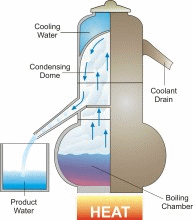Desalination gaining support as long-term response to CA drought
by John | April 2, 2015 9:18 am
 With California’s snowpack at the lowest level in a century[1], Governor Jerry Brown announced Wednesday the first mandatory water reductions in state history.
With California’s snowpack at the lowest level in a century[1], Governor Jerry Brown announced Wednesday the first mandatory water reductions in state history.
“Today we are standing on dry grass where there should be five feet of snow,” Governor Brown[2] said at a press event in the Sierra Nevada mountains. “This historic drought demands unprecedented action. Therefore, I’m issuing an executive order mandating substantial water reductions across our state.”
To combat the state’s ongoing drought, the governor has ordered the State Water Resources Control Board to implement a 25 percent reduction in water use by[3] local water agencies. He’s also calling on water districts to adopt conservation pricing, a streamlined permitting process for water projects and an investment in new water infrastructure technologies.
“People should realize we are in a new era,” the governor said. “The idea of your nice little green lawn getting watered every day, those days are past.”
Water everywhere, but only fraction from the sea
While conservation is the key element of the state’s short-term drought response, those latter provisions of the governor’s plan have many Californians turning to desalination as a promising long-term solution to the state’s water needs.
“The Governor’s Executive Order issued today is consistent with the policy goals established in the state’s Water Action Plan and clearly demonstrates his commitment to developing new local water supplies including seawater desalination,” said Scott Maloni, vice-president of Poseidon Water[4], a water development company that specializes in desalination.
For hundreds of years, sailors have found ways to remove salt and other impurities from the earth’s salt water[5] and turn it into drinking water. Today, that process has gone high-tech at more than 17,000 desalination plants in 150 countries around the world. According to the International Desalination Association[6], more than 300 million people use approximately 21.1 billion gallons of water produced from desalination every day.
 However, outside of the Middle East, where desalination is a vital component of the region’s water portfolio, desalination is responsible for just a fraction of the world’s drinking water.
However, outside of the Middle East, where desalination is a vital component of the region’s water portfolio, desalination is responsible for just a fraction of the world’s drinking water.
“Even with all of the water in Earth’s oceans, we satisfy less than half a percent of human water needs with desalinated water,” Peter Gleick, president of the Pacific Institute[7] and author of the book, The World’s Water, pointed out to Scientific American. “The problem is that the desalination of water requires a lot of energy.”
As of 2013, the California Department of Water Resources estimated[8] that desalinated water cost $2,000 an acre foot, or double the price of water from other sources. But, the high energy production costs aren’t stopping enterprising companies from entering the desalination market, rather it’s a lengthy and bureaucratic permitting process.
Desalination plants battle lengthy permitting process
Next year, a $1 billion desalination plant in Carlsbad[9] is expected to come online and produce 50 million gallons per day — after years of permitting battles with city governments and state agencies.
“They went through seven or eight years of hell to get here,” Tim Quinn, executive director of the Association of California Water Agencies, told the San Jose Mercury News last year[10]. “But they stuck it out. They got it done. If it succeeds, it will encourage others to try. And if it fails, it will have a chilling effect.”
 Poseidon Water, which spearheaded the Carlsbad Desalination Project, is now working to gain final approvals from the California Coastal Commission on a desalination plant in Huntington Beach that would also produce 50 million gallons per day.
Poseidon Water, which spearheaded the Carlsbad Desalination Project, is now working to gain final approvals from the California Coastal Commission on a desalination plant in Huntington Beach that would also produce 50 million gallons per day.
“A streamlined permitting process will significantly help our proposed Huntington Beach project become a reality,” said Maloni of Poseidon Water. “We are looking forward to bringing this project before the Coastal Commission for their approval this year and finally bringing a drought-proof water supply to millions of coastal residents.”
If the company gains its final discretionary approval from the Coastal Commission, the plant is scheduled to be operational by 2018[11]. That’s not soon enough, given the state’s dwindling water supplies. Earlier this year, the Orange County Water District announced[12] its intention to buy all of the 56,000 acre-feet of water produced by the plant.
“Desalination should be front and center”
The longer the drought persists, the more likely parched water agencies will be to add desalination plants as a component of their water portfolios.
“While conservation is a must, looking at ways to overcome the obstacles that have thwarted previous efforts on desalination should now be front and center in the water deliberations,” writes Joel Fox, editor of Fox & Hounds Daily[13]. “Proposals to desalinate water from the Pacific Ocean have run into environmental concerns and cost issues. … The thinking on the cost issue is changing, however, because of the severity of the drought, the increased value of water, and potential energy resources to make the process work.”
In order to change thinking about desalination, it will require overcoming challenges from environmentalists, who view desalination as a precursor to more development.
“If you’re going to do something like desal, you want to make sure you’re doing everything you can in terms of conservation, water recycling, water re-use,” Susan Jordan of the California Coastal Protection Network told KQED[14], “and you don’t want unsustainable development that just perpetuates your problem, or the state’s problem.”
- lowest level in a century: http://www.livescience.com/50344-california-snowpack-record-low-2015.html
- Governor Brown: http://ca.gov/drought/topstory/top-story-29.html
- water use by: http://www.nytimes.com/2015/04/02/us/california-imposes-first-ever-water-restrictions-to-deal-with-drought.html?_r=0
- Poseidon Water: http://poseidonwater.com/company/about_poseidon_water
- the earth’s salt water: https://water.usgs.gov/edu/drinkseawater.html
- International Desalination Association: http://idadesal.org/desalination-101/desalination-by-the-numbers/
- Peter Gleick, president of the Pacific Institute: http://www.scientificamerican.com/article/why-dont-we-get-our-drinking-water-from-the-ocean/
- California Department of Water Resources estimated: http://www.mercurynews.com/science/ci_25859513/nations-largest-ocean-desalination-plant-goes-up-near
- desalination plant in Carlsbad: http://carlsbaddesal.com/project-overview
- San Jose Mercury News last year: http://www.redding.com/news/desalination-plants-future-california-coast
- operational by 2018: http://poseidonwater.com/our_projects/all_projects/huntington_beach_project
- Orange County Water District announced: http://www.ocregister.com/articles/water-647592-poseidon-ocwd.html
- editor of Fox & Hounds Daily: http://www.foxandhoundsdaily.com/2015/04/finding-the-power-to-help-get-fresh-water-from-the-ocean/
- told KQED: http://blogs.kqed.org/science/audio/why-isnt-desalination-the-answer-to-all-californias-water-problems/
Source URL: https://calwatchdog.com/2015/04/02/desalination-gaining-support-as-long-term-response-to-ca-drought/